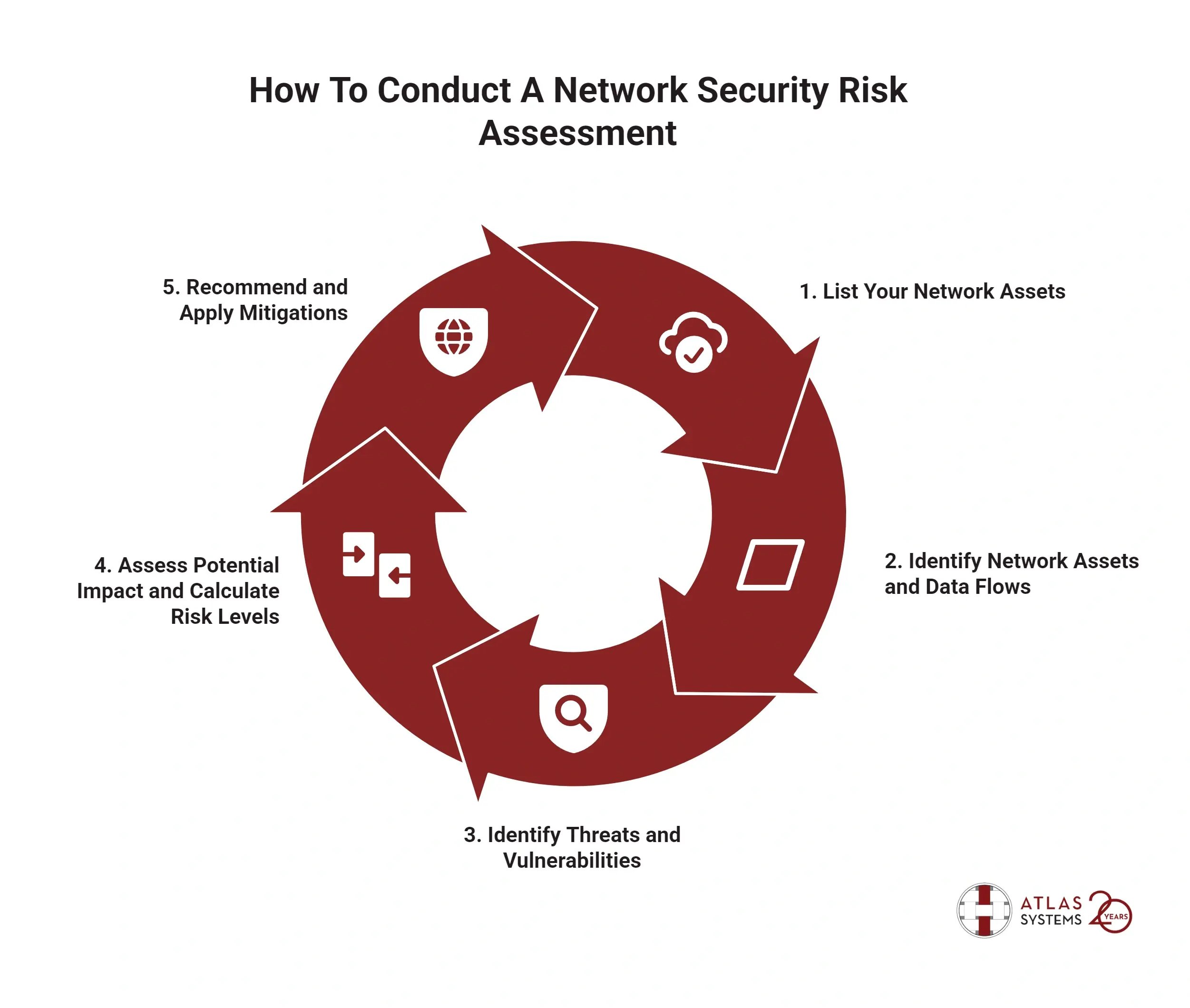Atlas Systems Named a Representative Vendor in 2025 Gartner® Market Guide for TPRM Technology Solutions → Read More

A Complete Guide to Conducting Network Security Risk Assessments


14 min read | Last Updated: 27 Nov, 2025
TL;DR
- $4.88M breach cost: 2024 average reached $4.88 million, 10% increase; 422.61 million records compromised Q3 alone demonstrating assessment criticality.
- Five-step methodology: List assets, map data flows using Nmap/Wireshark, identify threats with MITRE ATT&CK, assess impact, recommend technical mitigations.
- Compliance mandates: HIPAA, ISO, NIST, PCI DSS, GDPR require regular security assessments to maintain compliance and avoid hefty fines.
- Risk matrix prioritizes: Likelihood (1-5) paired with impact (1-5) calculates scores; critical risks like ransomware get 20 points versus IoT's 3.
In 2024, the global average cost of a data breach reached $4.88 million, a 10% increase from 2023. 422.61 million records were compromised in the third quarter alone. These figures prompt a closer look at how organizations protect their networks.
What exactly constitutes a network security assessment? It involves a detailed review of a network’s design, components, and security protocols using automated tools and manual inspections.
This process seeks to identify hidden vulnerabilities and potential risks before they become major issues. The following discussion examines network security assessments' nature, purpose, and methodology.
Network Security Assessment: Explained Simply
A network security assessment is a process used to check for weak spots in your network, such as areas that could become targets, disrupt business activities, or lead to data leaks. It helps organizations understand where they’re vulnerable and what needs fixing.
This assessment also plays a key role in meeting compliance requirements. Many regulations and frameworks expect businesses to assess their security risks regularly. These include:
- HIPAA (for healthcare data protection)
- ISO standards (for information security management)
- NIST Cybersecurity Framework
- PCI DSS (for payment card security)
- GDPR (for data privacy in the EU)
In short, it’s both a protective and regulatory must-do.
Why you should do network security risk assessment
The main goal of a network security risk assessment is to help you find and fix weak spots in your networks before they can be exploited. This can reduce the chances of a cyberattack and limit the damage if one occurs.
Here’s what a network security assessment typically aims to do:
- Pinpoint open entry points or gaps in your network
- Detect vulnerabilities in software, files, databases, and other areas
- Evaluate how an internal or external attack might affect your operations
- Test how well your current security setup can detect and respond to threats
- Support the ongoing development and improvement of your network’s security
How To Conduct A Network Security Risk Assessment?

1. List your network assets
List all network assets that need assessment, servers, routers, endpoints detection, cloud environments, third-party integrations, etc.
How to do it:
- Identify business-critical systems.
- Determine compliance requirements (e.g., HIPAA, PCI DSS).
- Set the boundaries, internal vs. external assets, production vs. development environments.
2. Identify network assets and data flows
Map out every device, system, and connection point interacting with your network, and trace how data moves between them.
You can’t protect what you don’t see. Shadow IT, forgotten devices, and undocumented third-party services often become the soft spots that attackers exploit.
Surprisingly, many breaches originate from assets assumed to be insignificant or overlooked during initial scans. A printer with outdated firmware or an abandoned test server can be all it takes.
How to do it:
- Run network discovery tools like Nmap or Wireshark to get visibility into connected devices and traffic behavior. These tools detect live hosts, open ports, running services, and unusual communication patterns.
- Document asset inventory in detail, including IP addresses, operating systems, device types, usage roles (e.g., database server vs. end-user workstation), ownership, and criticality. Include both physical and virtual assets across on-prem and cloud environments.
- Map data flows. Go beyond a static list. Visualize how sensitive information (e.g., PII, credentials, financial data) moves through the network. Identify where it’s stored, processed, and transmitted, especially between internal systems and external vendors or SaaS platforms.
3. Identify threats and vulnerabilities
Analyze internal and external risks that could exploit weaknesses in your systems, configurations, and user practices.
Most breaches don’t begin with complex tactics; they start with the low-hanging fruit: an outdated patch, a weak password, or an open port that’s been forgotten. The real challenge isn’t fighting off attacks but identifying the cracks before someone else does.
How to do it:
- Use threat intelligence feeds like MITRE ATT&CK to understand real-world attack patterns, tactics, and techniques relevant to your industry and tech stack.
- Conduct regular vulnerability scans using tools like Nessus or Qualys to identify missing patches, misconfigurations, and exposed services.
- Review internal data, audit logs, login patterns, system alerts, and past incident records to detect suspicious activity or recurring weak points.
For example, Atlas Systems’ Cybersecurity Risk Assessment Software takes this process further. A detailed scan and analysis identifies security gaps, outdated software, and misconfigured systems that could expose your organization.
You will get a clear, actionable report that breaks down each vulnerability and its associated risk. With Atlas, you strengthen your cybersecurity posture and proactively manage risks before they escalate.
4. Assess potential impact and calculate risk levels
Identify what could go wrong if a known vulnerability is exploited, and prioritize which risks need immediate attention based on their likelihood of occurring and the damage they could cause.
Not every threat deserves the same level of urgency. Some might lead to temporary service disruption, while others could expose sensitive data or trigger regulatory penalties.
How to do it:
- Evaluate potential consequences across multiple dimensions: data loss, system downtime, financial costs, regulatory fines, and brand damage.
- Factor in cascading effects, if a critical system is compromised, what other systems or services would be affected downstream?
- Assign risk levels by pairing the likelihood of a threat occurring with its impact. Use a risk matrix to guide decisions and remediation priorities.
Risk Assessment Matrix (Sample)
|
Threat |
Vulnerability |
Likelihood (1–5) |
Impact (1–5) |
Risk Score (L x I) |
Risk Level |
Comments |
|
Ransomware via Phishing Email |
Untrained employees |
4 |
5 |
20 |
Critical |
High potential for data encryption, ransom demands, and service disruption. |
|
Data breach from exposed database |
Misconfigured firewall |
3 |
5 |
15 |
High |
This could lead to PII leak and compliance violations. |
|
DoS attack on public server |
Lack of rate limiting |
2 |
3 |
6 |
Medium |
Temporary disruption, but no data is at risk. |
|
Credential stuffing |
Weak password policy |
3 |
2 |
6 |
Medium |
There is a low impact per event but could add up over time. |
|
Insider data leak |
Excessive access permissions |
2 |
4 |
8 |
Medium |
Needs access reviews and user behavior monitoring. |
|
Unauthorized IoT access |
Default device credentials |
1 |
3 |
3 |
Low |
Limited exposure is still worth addressing during the patch cycle. |
5. Recommend and Apply Mitigations
Choose and implement controls that reduce each identified risk to a level yourthe organization is comfortable accepting, balancing security with operational feasibility.
Finding risks is only half the equation. The real value comes from how effectively you respond to them. Not all threats can be eliminated, but they can be managed with technical controls, user awareness, and clear policies.
How to do it:
- Apply technical safeguards:
- Firewalls to filter traffic at network perimeters
- Intrusion Detection/Prevention Systems (IDS/IPS) to monitor and block malicious activity
- Access controls to ensure users only access what they need
- Encryption to protect data in transit and at rest
- Patch management to eliminate known vulnerabilities quickly
- Implement structural security:
- Multi-factor authentication (MFA) to block unauthorized access—even if passwords are compromised
- Network segmentation to isolate sensitive systems, limiting the blast radius of an attack
- Strengthen governance:
- Update or create security policies covering acceptable use, incident response, data handling, and access control.
- Educate employees through periodic training on social engineering, phishing, and secure behavior.
Network Security Assessment Report Sample
Here is a network security assessment report sample
|
Prepared for: [Client Name] 1. Executive Summary This assessment evaluates the current state of network security across [Client Name]’s infrastructure. It identifies existing vulnerabilities, categorizes them based on severity, and recommends actionable remediation steps. The objective is to strengthen the client’s security posture, reduce potential attack surfaces, and ensure business continuity. Scan Scope:
2. Scan Methodology
3. Key findings
4. Risk Assessment Top Critical Vulnerabilities
Insight: 5. Recommendations
6. Remediation Plan
7. Ongoing Monitoring and Reassessment Network environments evolve rapidly. New assets, configurations, or updates can reintroduce risk. Regular assessments and continuous monitoring are strongly recommended. |
Automate Network Security Assessments With Atlas System
Risk assessments must be carried out regularly and when any major changes take place in your network. The problem? Doing manual assessments every time can be time-consuming and leave room for error.
Instead of chasing issues after they’ve caused trouble, you can automate the entire process and stay ahead of threats. That’s where Atlas Systems steps in.
We know your business data is critical. That’s why our AI-driven cybersecurity risk assessment platform helps you uncover vulnerabilities before they turn into costly problems.
Here’s what you get from Atlas:
- Vulnerability assessment: Uses AI-driven scans to detect outdated software, misconfigurations, and known security flaws.
- Penetration testing: Simulates real-world cyberattacks to uncover exploitable weaknesses that might be missed by automated scans. Provides a realistic view of how your systems would perform under active threat conditions.
- IT risk assessment: Evaluates your full IT environment, including infrastructure, data protection measures, and regulatory alignment. Also, offers tailored recommendations to close gaps and support compliance.
- End-to-end risk management loop: Combines vulnerability scanning, attack simulation, and environment-level risk reviews into one continuous improvement cycle.
- Backed by experience and scale: Atlas has 20+ years in cybersecurity and IT services and has 100,000+ assessments completed.
Interested? Get on a call with us to know more.
FAQs about network security assessment
How often should a business perform a network security assessment?
At a minimum, businesses should conduct a network security assessment annually. However, additional assessments are recommended after any major changes, such as system upgrades, network expansion, or new integrations.
Can small businesses perform network security assessments on their own?
Yes, small businesses can perform basic assessments using free or low-cost tools, especially if they have some in-house IT support. However, a DIY approach often lacks depth, and certain vulnerabilities or misconfigurations can go unnoticed.
Are there any free tools available for network security assessments?
Yes, there are free tools available for network security assessments. While these can offer valuable insights, they require some technical knowledge to interpret correctly. Hence, for more structured assessments, we suggest you with platforms like Atlas Systems.
How do I choose a reliable vendor for network security assessment services?
Look for vendors with proven experience, clear methodology, transparent deliverables, client references or case studies and responsiveness and willingness to tailor services to your needs
What certifications should a professional network security assessor have?
Look for assessors with industry-recognized certifications such as:
- CISSP (Certified Information Systems Security Professional)
- CEH (Certified Ethical Hacker)
- OSCP (Offensive Security Certified Professional)
- CISA (Certified Information Systems Auditor)
Related Reading
Blogs
.png?width=869&height=597&name=image%20(5).png)

.png?width=300&height=175&name=Rectangle%2034624433%20(2).png)







.png?width=645&height=667&name=Widgets%20(2).png)







.png)

